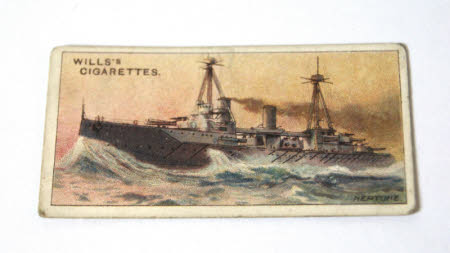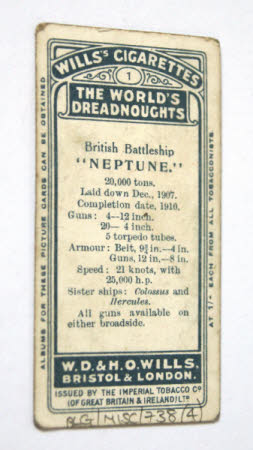Cigarette card
Wills's Cigarettes
Category
Ephemera
Date
Unknown
Materials
Card
Measurements
35 mm (Width); 67 mm (Length)
Order this imageCollection
Mr Straw's House, Nottinghamshire
NT 742586.4
Summary
One of a set of mismatched cigarette cards wrapped in a piece of newspaper. Cigarette card, the front has a full colour picture of a battle ship on stormy seas with a red sky, with 'WILLS's CIGARETTES.'. On the back printed in blue ink on a white background; 'WILLS's CIGARETTES 1 THE WORLD'S DREADNOUGHTS British Battleship "NEPTUNE." 20,000 tons. Laid down Dec., 1907. Completion date, 1910. Guns: 4-12 inch. 20-4 inch. 5 torpedo tubes. Armour: Belt, 91/4 in.-4in. Guns, 12in.-8in. Speed: 21 knots, with 25,000 h.p. Sister ships: Colossus and Hercules. All guns available on either broadside. W.D.&H.O.WILLS. BRISTOL&LONDON. ISSUED BY THE IMPERIAL TOBACCO Co. (OF GREAT BRITAIN & IRELAND)LTD.'. Printed vertically up each side; 'ALBUMS FOR THESE PICTURE CARDS AN BE OBTAINED' 'AT 1\- EACH FROM ALL TOBACCONISTS.'. The ship was named after Neptune was the god of freshwater and the sea in Roman religion. He is the counterpart of the Greek god Poseidon. In the Greek-influenced tradition, Neptune was the brother of Jupiter and Pluto; the brothers presided over the realms of Heaven, the earthly world, and the Underworld. Salacia was his wife. HMS Neptune was a dreadnought battleship built for the Royal Navy in the first decade of the 20th century, the sole ship of her class. The ship was the first British battleship to be built with superfiring guns. Shortly after her completion in 1911, she carried out trials of an experimental fire-control director and then became the flagship of the Home Fleet. Neptune became a private ship in early 1914 and was assigned to the 1st Battle Squadron (BS).The ship became part of the Grand Fleet when it was formed shortly after the beginning of the First World War in August 1914. Aside from participating in the Battle of Jutland in May 1916, and the inconclusive Action of 19 August several months later, her service during the war generally consisted of routine patrols and training in the North Sea. Neptune was deemed obsolete after the war and was reduced to reserve before she was sold for scrap in 1922 and subsequently broken up. Neptune, was ordered on 14 December 1908. She was laid down at HM Dockyard, Portsmouth on 19 January 1909, launched on 30 September and completed in January 1911 at the cost of £1,668,916, including her armament. The ship was commissioned on 19 January 1911 for trials with an experimental director designed by Vice-Admiral Sir Percy Scott. The final trials were conducted on 11 March at Gibraltar and were witnessed by Rear-Admiral Sir John Jellicoe, commander of the Atlantic Fleet. Neptune became a private ship on 10 March 1914 when she was replaced by Iron Duke as the flagship of the Home Fleet and rejoined the 1st BS. Between 17 and 20 July 1914 Neptune took part in a test mobilisation and fleet review as part of the British response to the July Crisis. Arriving in Portland on 27 July, she was ordered to proceed with the rest of the Home Fleet to Scapa Flow two days later to safeguard the fleet from a possible German surprise attack. In August 1914, following the outbreak of the First World War, the Home Fleet was reorganised as the Grand Fleet, and placed under the command of Admiral Jellicoe. On the evening of 22 November 1914, the Grand Fleet conducted a fruitless sweep in the southern half of the North Sea; Neptune stood with the main body in support of Vice-Admiral David Beatty's 1st Battlecruiser Squadron. The fleet was back in port in Scapa Flow by 27 November and the ship began a refit on 11 December. On the evening of 23 January, the bulk of the Grand Fleet sailed in support of Beatty's battlecruisers, but the fleet was too far away participate in the ensuing Battle of Dogger Bank the following day.
Makers and roles
Wills's Cigarettes , manufacturer


